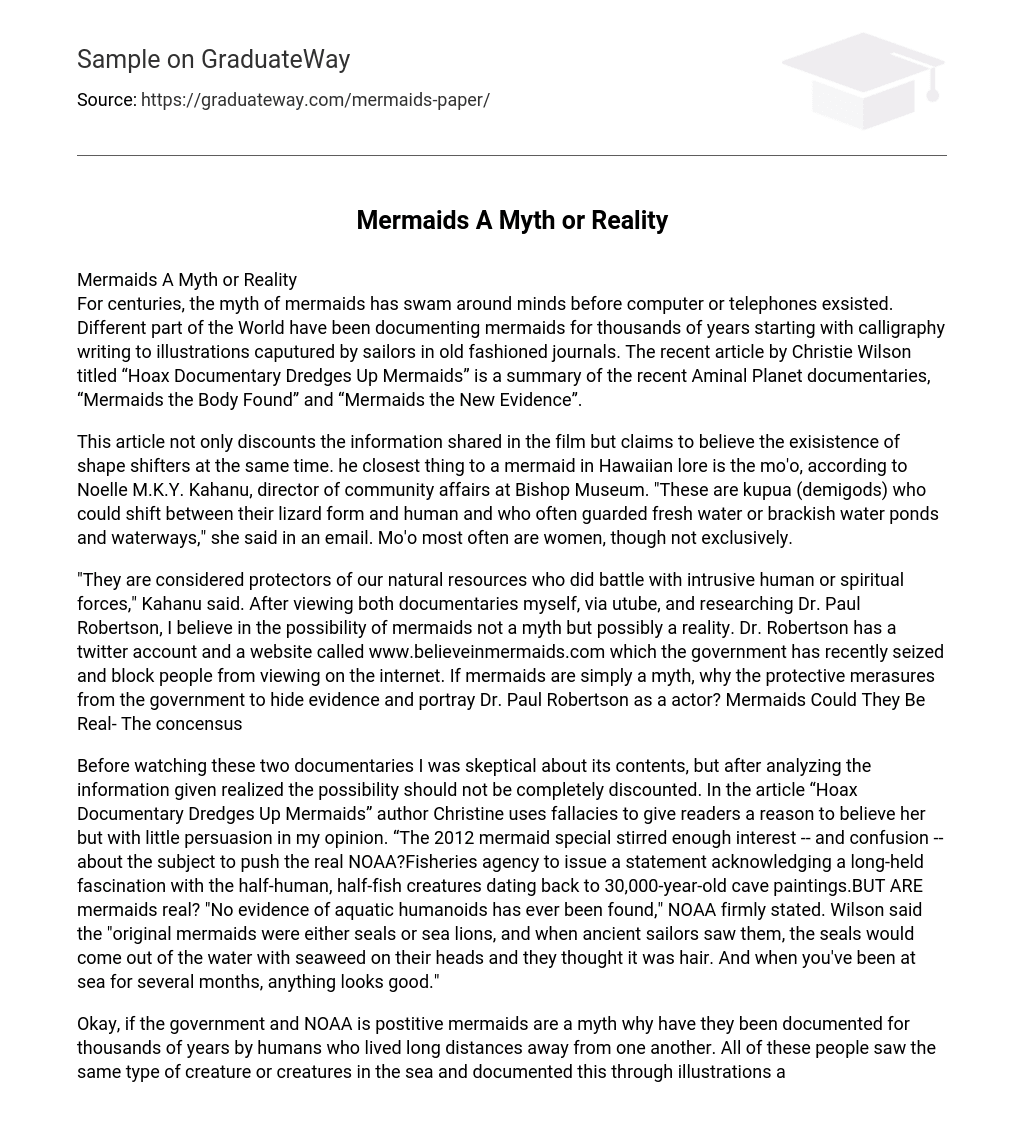Throughout history, the myth of mermaids has captivated imaginations long before the existence of computers or telephones. Various regions of the world have been recording accounts and depicting mermaids for centuries, initially through calligraphy and later through illustrations found in sailors’ journals. Christie Wilson’s article, titled “Hoax Documentary Dredges Up Mermaids,” provides an overview of the recent Animal Planet documentaries, “Mermaids the Body Found” and “Mermaids the New Evidence.”
According to Noelle M.K.Y. Kahanu, director of community affairs at Bishop Museum, this article discounts the information shared in the film while simultaneously believing in the existence of shape shifters. In Hawaiian folklore, the closest thing to a mermaid is the mo’o. “These are kupua (demigods) who could shift between their lizard form and human and who often guarded fresh water or brackish water ponds and waterways,” she explained in an email. Mo’o are typically women, though not exclusively.
According to Kahanu, mermaids are seen as protectors of nature who fight against human or spiritual intruders. Although I watched both documentaries on YouTube and looked into Dr. Paul Robertson, I now think that mermaids could be more than just a myth—they might actually exist. Dr. Robertson has a Twitter account and a website titled www.believeinmermaids.com, but recently the government has taken control of it and blocked people’s access to it online.
If mermaids are just a myth, then why is the government taking protective measures to conceal evidence and depict Dr. Paul Robertson as an actor? Prior to watching these two documentaries titled “Mermaids Could They Be Real,” I had doubts about their contents. However, upon analyzing the presented information, I realized that the possibility of mermaids should not be entirely dismissed. In Christine’s article titled “Hoax Documentary Dredges Up Mermaids,” she employs fallacies to convince readers, but in my opinion, her persuasion is weak.
“The 2012 mermaid special sparked enough interest — and confusion — regarding the topic, leading the actual NOAA?Fisheries agency to release a statement acknowledging a longstanding fascination with the half-human, half-fish creatures dating back to 30,000-year-old cave paintings. However, is it possible for mermaids to be real? “No evidence of aquatic humanoids has ever been discovered,” NOAA firmly asserted. Wilson proposed that the “original mermaids were either seals or sea lions, and when ancient sailors observed them, the seals would emerge from the water with seaweed on their heads, which they mistook for hair. And after spending months at sea, anything appears appealing.”
The government and NOAA deny the existence of mermaids, but it is peculiar that humans from different regions have independently documented encounters with similar sea creatures through illustrations and writings for thousands of years. These sightings must have been deemed significant and worthy of sharing with future generations. Christine emphasizes her perspective on these accounts in her article, stating that aside from fictional portrayals in Disney movies and poolside performances, mermaids do not exist.
On May 26, the cable network premiered “Mermaids the Body Found,” a fictional documentary that attracted the largest audience to date, with 3.6 million viewers. An interesting aspect of this program was the significant social media buzz that followed, which raised questions about why so many individuals were open to considering the fabricated evidence being presented by actors portraying experts.
First, it is crucial to inquire about the source of her knowledge regarding the fabrication of evidence and the use of actors in the aforementioned programs. Personally, I have watched both programs and have not encountered any disclaimers indicating the presence of counterfeit evidence or performers. Ultimately, Dr. Paul Robertson is a real person whose information and websites are readily available on platforms such as Google, Twitter, YouTube, among others. These sources offer comprehensive details on mermaids and the rationale behind his conviction in their existence.
The documentaries on Animal Planet by this individual focus on the possible evolution of mermaids and their relationship with humans. Two marine biologists obtained impressive evidence by diving deep into the ocean and using a bloop signal to attract mermaids. After hours of filming, they captured footage of a creature that closely resembled a mermaid approaching their vessel, which was clearly visible when the tape was slowed down for detailed examination. Considering information from the article and other sources, it becomes clear that there is more support for the existence rather than nonexistence of mermaids.
References
- Wilson, C. (2013, Jun 06). Hoax documentary dredges up mermaids, Honolulu Star-Advertiser. Retrieved from http://search .proquest.com/docview/1365621111
- Mermaids not real ‘mon, now. (2012, Jul 05). Virginian – Pilot. Retrieved from http://search.proquest.com/docview/1023338644?accountid=458





